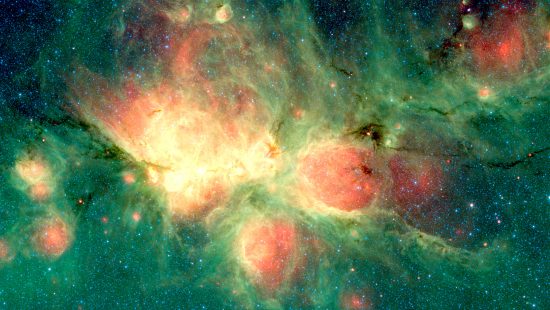
January 9, 2020
Nebulae display their true natures, but convention is unable to see them.
“Imagination is a beast that has to be put in a cage.”
— Timothy Spall
NGC 6334, the Cat’s Paw nebula, is also known as the Bear Claw nebula. It is 50 light-years across and approximately 5500 light-years away, as astronomers calculate distance. The glowing cloud is part of a larger nebular complex near the heart of the Milky Way and includes NGC 6357, the Lobster.
According to a recent press release, NGC 6334 includes a star-forming region where hundreds of blue-white stars far more massive than the Sun are seen. As stated in the press release, the nebula is a prolific stellar nursery, with a potential population of new stars numbering in the thousands, although the dusty environment makes it difficult to observe most of them.
From an Electric Universe viewpoint, the bubble located in the lower right of the image is an interesting feature. NASA proposes that it is a dying star ejecting its outer layers, or perhaps the expanding remnant of a star that has already exploded. However, the converging radial filaments are likely indicators of an interstellar Birkeland current that is “pinching down” in an hourglass shape. Rather than a bubble, it might instead be the barrel of a vortex, or z-pinch.
An electromagnetic z-pinch can squeeze plasma with such force that it rapidly compresses. Electric charge flowing into the pinch might cause plasma to erupt in an arc-mode discharge. Nebulae are plasma structures, so they behave according to the laws of electric discharges and circuits.
Near the center of the Milky Way there is an abundance of electromagnetic energy, so stars are born in the densest accumulation of electric charge. Stars are not formed in a gravitational vise, but in the electric nature of the Universe and moving plasma. Previous Pictures of the Day explain that electric discharges in a plasma cloud (a nebula) can create double layers, or sheaths, along the current axis. Those charged particles spiral into filaments, or double layers, which attract each other. Instead of merging they twist around into a helix, gradually pinching down into powerful electric discharges.
Spitzer is an infrared telescope, so it can “see through” clouds of dust. The filaments bisecting the nebula are areas so dense that infrared light cannot pass through them. Consensus astronomers think that they are regions where new stars will be created.
Since stars are born when electric discharges in plasma reach an arc-mode state, the more intense the electric current the bluer, larger, and more energetic the star. NGC 6334 is in a highly energized state, so it is rapidly creating massive blue-white stars. The green areas, as the press release states, are thought to show where “…radiation from hot stars collided with large molecules called ‘polycyclic aromatic hydrocarbons,’ causing them to fluoresce.”
Stars are electrical.
Stephen Smith
The Thunderbolts Picture of the Day is generously supported by the Mainwaring Archive Foundation.












